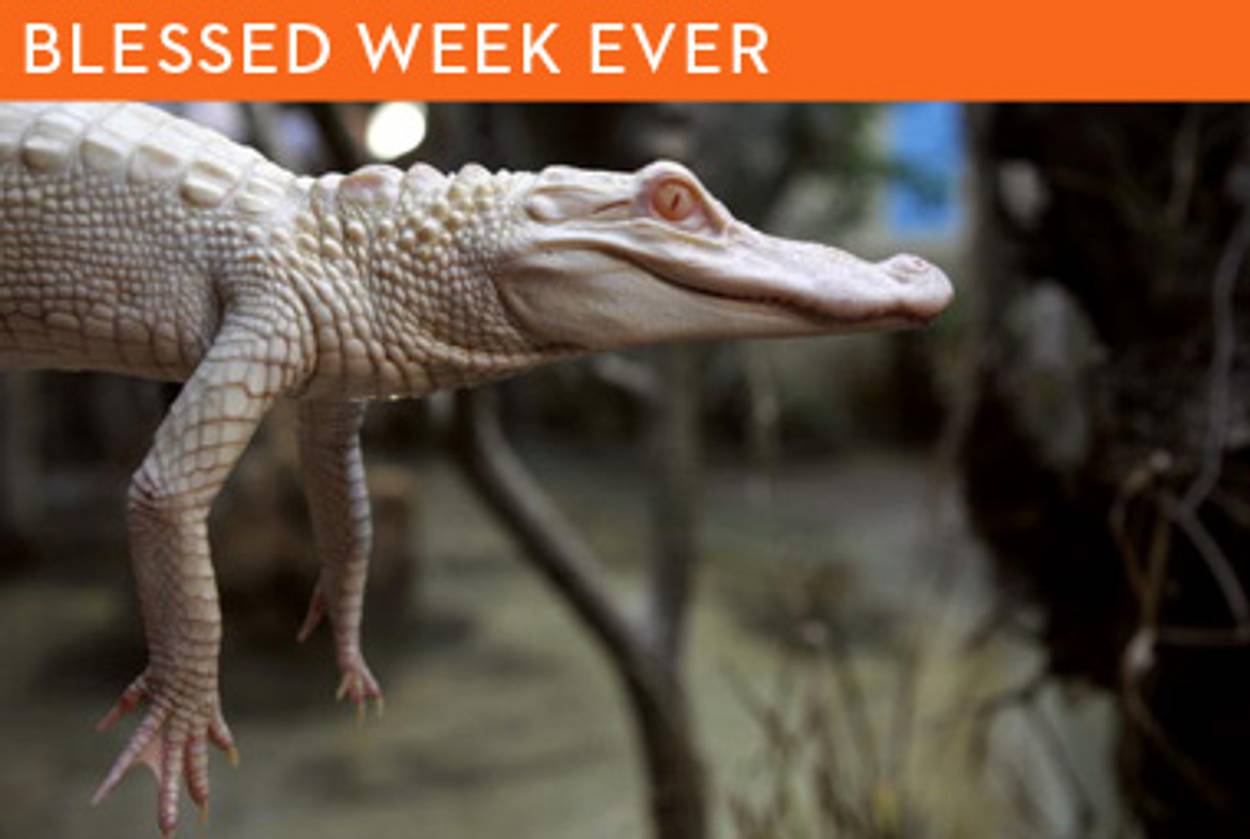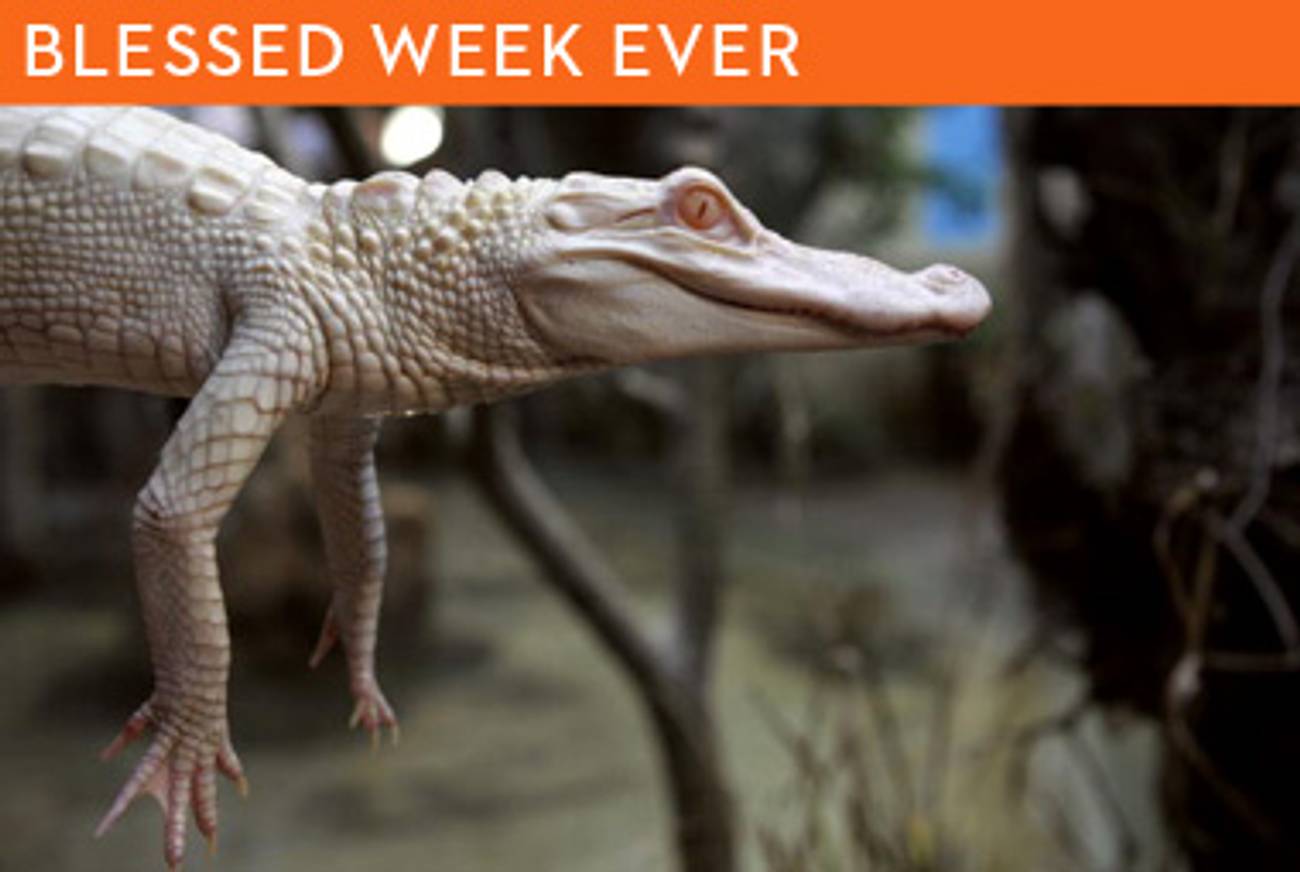True Crocodiles
Werner Herzog and Moses agree: Truth reveals itself in mysterious ways, hidden from the cold and critical eye and available only to those prepared to indulge in fantasies




At the end of his most recent documentary, Cave of Forgotten Dreams, German director Werner Herzog affixed a few minutes of footage he labeled a post-script. Having spent the entire film exploring the stunning, ancient artwork discovered in the Chauvet caves in southern France, believed to be more than 30,000 years old, Herzog ends with a coda involving crocodiles. To be precise, they’re albino mutant crocodiles. Deformed by the toxic waste of a nearby nuclear power plant, they swim in a contaminated pool a short distance away from the caves, contemplating creation.
They’re unsettling beasts, these crocodiles, and not just for their eerie absence of pigmentation: After many long shots fawning over the stunning creations of humanity’s earliest artists, Herzog’s camera drowns us in the water with these spooky creatures, and our feelings of awe and elation quickly turn to dread and disgust.
Herein lies the genius of the filmmaker. Anyone else, most likely, would have seized on the opportunity to film at Chauvet and made a ponderous and prim movie, all close-ups of cave paintings and soliloquies about mankind’s innate ingenuity. Not Herzog; he allows us a glimpse of beauty, and then forces us to consider the price that mankind, another mutated species that eventually fell victim to its own progress, paid to obtain it.
The crocodile scene is a powerful moment of documentary filmmaking. It also happens to be completely fake: These crocodiles were Louisiana-born, imported to France for a tourist attraction. Their albinism is a natural condition, not a mutation, and while there is indeed a nuclear plant nearby, its cooling waters are not radioactive. Oh, and these animals on screen happen to be alligators.
Herzog himself happily confessed to this bit of film forgery. Appearing last week on The Colbert Report, he defended his style of documentary filmmaking, devoted not to facts but to unveiling what he calls the “ecstatic truth” of his subject matter.
“I want the audience with me in wild fantasy in something that illuminates them,” Herzog told an uncharacteristically deferential Colbert. “You see, if I were only fact based, the book of books in literature then would be the Manhattan phone directory—four million entries, everything correct. But it flies out of my ears, and I do not know: Do they dream at night? Does Mr. Jonathan Smith cry in his pillow at night? We do not know anything when we check the correct entries in the phone directory. I am not this kind of a filmmaker.”
To the schoolmarms, of which our news media employ great and many, this kind of talk is gobbledygook; things, flightless minds insist, are either true or false. And, in light of so many fake memoirs, fibbing politicians, and other accounts of the rich and famous dissembling freely, it’s tempting to subscribe to that narrow point of view. But Herzog is here to remind us that truth is a more complicated matter.
So’s Moses. In this week’s parasha, the Israelite leader presents his own version of ecstatic truth. Standing on the cusp of Canaan, he sends 12 spies to tour the strange new land; when they return, 10 of them have some bad news: “They spread an evil report about the land which they had scouted,” reads the parasha, “telling the children of Israel, ‘The land we passed through to explore is a land that consumes its inhabitants, and all the people we saw in it are men of stature.’ ” These men, continued the 10 spies, include the Hittites and the Jebusites, the Amorites and the Amalekites, strong and well-armed peoples who were unlikely to take kindly to a small and ragged band of desert-dwellers claiming this already densely populated sliver of earth as their very own divinely sanctioned Promised Land.
It’s a reasonable, factual report, and, reasonably, it sends the Israelites into hysterics. But the two remaining spies, Joshua and Caleb, stand firm. The land, they insist, is the Israelites’ for the taking. “We can surely go up and take possession of it,” Caleb thunders, but no one listens. No one, that is, but Moses: He has another one of his stern conversations with God, at the end of which the 10 fact-based spies are put to death by the plague, leaving Caleb and Joshua standing firm and the people somewhat more heartened.
Caleb and Joshua, then, are the Werner Herzogs of their time. Rather than describe Canaan as it is, they talk of it as it should be, an idyllic spot, a spiritual haven. And that, it turns out, is the right approach—the facts drive people to tears, but the ecstatic truth moves them to action.
Besides, the facts may not be so factual after all: In an 1873 essay titled “On Truth and Lies in a Nonmoral Sense,” Friedrich Nietzsche took umbrage at our notion of truth. Truth, he said, was nothing more than “a mobile army of metaphors, metonyms, and anthropomorphisms—in short, a sum of human relations which have been enhanced, transposed, and embellished poetically and rhetorically, and which after long use seem firm, canonical, and obligatory to a people: truths are illusions about which one has forgotten that this is what they are; metaphors which are worn out and without sensuous power; coins which have lost their pictures and now matter only as metal, no longer as coins.”
This, of course, should not be interpreted as a passport to nihilism, as Nietzsche’s more boorish fans too often assume. Nor should it be read as a license to argue that religious truth should supplant ethical obligations and objective concerns, a view that is sometimes, and often too simplistically, attributed to the philosopher Søren Kierkegaard. Instead, the lesson we are to learn from Joshua and Caleb and those colorless crocodiles is that truth and light often hide in strange, shadowy places, places that the cold and critical eye can never penetrate. To see things clearly, sometimes we need to close our eyes and look for some wild fantasy to inspire us.
Liel Leibovitz is a senior writer for Tablet Magazine and a host of the Unorthodox podcast.
Liel Leibovitz is editor-at-large for Tablet Magazine and a host of its weekly culture podcast Unorthodox and daily Talmud podcast Take One. He is the editor of Zionism: The Tablet Guide.